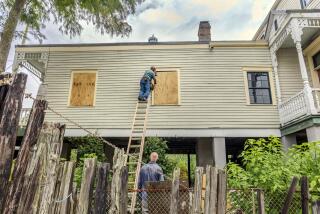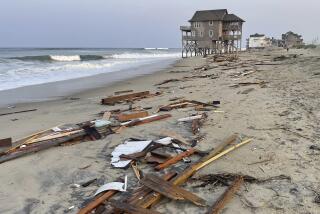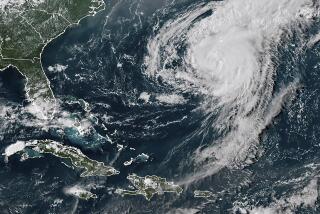El Niño’s latest trick: Another calmer hurricane season expected
When it comes to disasters, El Niño giveth and El Niño taketh away.
The same developing El Niño that may have helped unleash massive, deadly floods on Oklahoma and Texas this week — and the same El Niño that could summon rains to drought-scorched California next winter — is expected to bring another relatively quiet hurricane season for the eastern U.S. this summer.
The Atlantic Ocean is expected to see only two or fewer major hurricanes this year, and no more than six hurricanes overall, the National Oceanic and Atmospheric Administration said in its annual hurricane forecast Wednesday.
Hurricane season officially begins June 1 and runs to Nov. 30. An average season typically has about six hurricanes, with winds of 74 mph or higher, and three major Category 3 hurricanes with devastating winds of at least 111 mph.
The below-average 2014 season had only two major hurricanes, as NOAA had predicted. However, one weaker Category 2 storm, Hurricane Arthur, became the earliest storm to make landfall in North Carolina since records began in 1851; it hit the state July 3 and caused power outages and surge flooding.
The hurricane season in 2013 was the weakest since 1994, with only two storms reaching Category 1 status, the weakest of the hurricane categories. In 2012, Superstorm Sandy slammed into New York City and America’s Northeast, killing 73 people and causing billions of dollars in damage.
“The main factor expected to suppress the hurricane season this year is El Niño,” Gerry Bell, lead seasonal hurricane forecaster with NOAA’s Climate Prediction Center, said Wednesday in an announcement.
The reason? El Niño — an uncommon phenomenon when warmer waters visit the eastern Pacific Ocean — may change global wind and pressure patterns in a way that would calm the more hurricane-prone Atlantic.
NOAA scientists peg the odds of a below-average 2015 hurricane season at 70%. But even if they’re right, that doesn’t mean the Eastern Seaboard and the Caribbean are off the hook.
“It only takes one hurricane or tropical storm
making landfall in your community to significantly disrupt your life,” said Joseph Nimmich, deputy administrator of the Federal Emergency Management Agency, in a statement. “Everyone should take action now to prepare themselves and their families for hurricanes and powerful storms.”
Texas and Oklahoma have learned that the hard way, for an entirely different type of disaster — flooding — that some meteorologists have also attributed to El Niño’s similarly distant influence.
At least 19 people have been killed since the weekend as a series of storms have dumped rain on Oklahoma and Texas.
A five-year extreme drought in both states was almost totally wiped out by a month of repeated storms, culminating in the weekend’s disastrous deluges.
The nonstop Texas-Oklahoma rains are probably being influenced by a building El Niño in the eastern tropical Pacific Ocean, whose warm waters tend to bring rain to the southern U.S., said Bill Patzert, a climatologist at NASA’s Jet Propulsion Laboratory in La Cañada Flintridge.
If a full-blown El Niño develops, that could mean rain for Southern California next winter, and it could mean trouble too, Patzert said.
The last El Niño, in 1997-98, brought floods, mudslides and disaster declarations in at least 40 California counties as the state was pounded with rain for month after month.
“The headlines that you’re writing today about Texas and Oklahoma, you could be writing about California in January,” Patzert told the Los Angeles Times on Sunday. “There’s something to remember about El Niño: He’s a good boy and he’s a bad boy because he can deliver drought relief that’s much-needed. But all that water coming so fast is like trying to catch water out of a fire hose with a champagne glass.”
Follow @MattDPearce for national news
More to Read
Sign up for Essential California
The most important California stories and recommendations in your inbox every morning.
You may occasionally receive promotional content from the Los Angeles Times.










